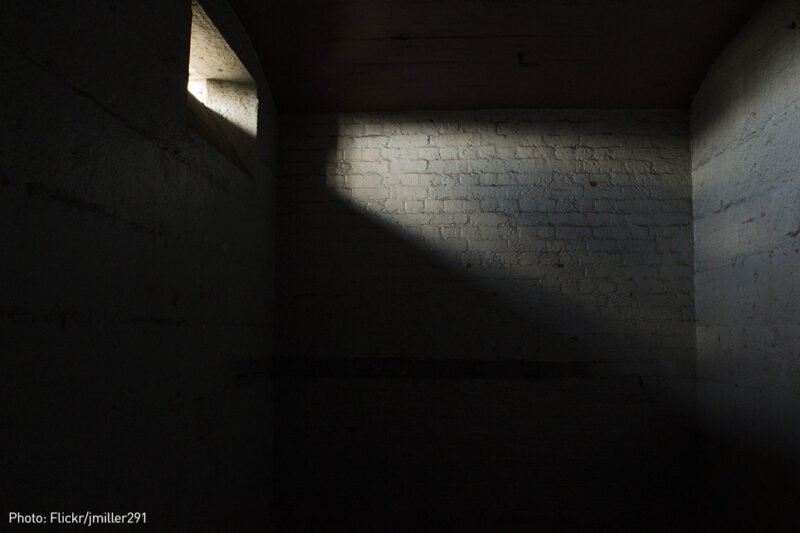Is This the Beginning of the End for Solitary Confinement in the United States?


Solitary confinement is a cruel and all too usual punishment in our country today. But there’s big change in the air.
The Supreme Court recognized over a century ago that solitary confinement causes intense suffering and has been observed to drive people insane. Yet there are still 80,000 to 100,000 prisoners in isolation in the U.S., typically in tiny windowless cells, deprived of virtually all human contact, in some cases for decades. Anthony Graves, who spent 16 years in solitary in a Texas prison before he was exonerated of murder, has said that solitary “seems designed to break a man’s will to live.”
Solitary became a widespread and deeply embedded practice in the U.S. in the 1980s and '90s when states around the country went on a building spree to construct super-max prisons designed to hold thousands in prolonged solitary — symbols that politicians were “tough on crime.” It’s been a tough struggle to expose this barbaric practice for what it is: torture.
Prison administrators have insisted that prolonged solitary is only used for “the worst of the worst” inmates and that it’s essential to keep other prisoners safe. That claim simply isn’t true, as many prison administrators warehouse people with serious mental illness in solitary as a cheap alternative to providing them with treatment. The task for prisoners’ rights advocates has been to gather and present the evidence — to the courts, the state and federal legislatures, the media, and, most importantly, the court of public opinion — that prolonged solitary is not only profoundly damaging, especially so for kids and for people living with mental illness, but also that it has been wildly overused and is unnecessary and counterproductive for safe prisons and safe communities.
The national movement to end solitary confinement is only a few years old. The StopMax campaign was founded in 2008. The watchdog group Solitary Watch launched in 2009. And the movement got a big boost of new energy in 2010 with the launch of the Stop Solitary campaign. Since then it has been gaining even more momentum — and in recent months that momentum has been accelerating to a breath-taking pace.
In May 2015, the United Nations Commission on Crime Prevention and Criminal Justice approved a new rule that solitary confinement shall be used only in exceptional cases. And when it is used, it will be a last resort for as short a time as possible and subject to independent review. The commission also condemned prolonged solitary confinement — defined as more than 15 consecutive days. Even though the rules aren't binding, they represent a global consensus on minimum standards for the treatment prisoners, and it’s important that the US delegation strongly endorsed them.
A month later, U.S. Supreme Court Justice Anthony Kennedy went out of his way — in a concurring opinion in a capital punishment case — to criticize the practice of solitary confinement, which was not an issue in the case presented to the court. The justice pointed to the "terrible price" of prolonged solitary confinement on prisoners' mental and physical health. More importantly, he practically invited prisoners to bring a case to the high court “to determine whether workable alternative systems for long-term confinement exist, and, if so, whether a correctional system should be required to adopt them." This is a big deal since the Supreme Court has rarely considered solitary and has never ruled that solitary violates the 8th Amendment ban on cruel and unusual punishment.
Then in July, President Obama became the first president to visit a U.S. prison and to question the use of solitary. At an NAACP conference, he asked, “Do we really think it makes sense to lock so many people alone in tiny cells for 23 hours a day, sometimes for months or even years at a time?” Now he has ordered the Justice Department to review the use of solitary in federal prisons.
On September 1, the state of California entered into a landmark settlement of a class action on behalf of prisoners in solitary at the notorious Pelican Bay prison. The state not only agreed that mere gang membership doesn’t justify isolation, but it agreed to enact wide-reaching reforms, such as moving thousands of California prisoners out of solitary, allowing the rest to work their way to general population through programming and good behavior, and allowing significantly more out-of-cell time for those who remained in isolation. This agreement could well have enormous influence in other states since California has had the second highest population of prisoners in the nation and prison officials have adamantly insisted for years that their heavy reliance on long-term solitary was essential to control gang violence.
Two days after the ground-breaking California settlement, the Association of State Correctional Administrators — a national organization for prison and jail administrators, whose policies have been in large part responsible for the widespread use of solitary — publicly announced that it is committed to “ongoing efforts to limit or end extended isolation,” which it called “a grave problem in the United States.”
It could be that this accelerating change signals the beginning of the end of prolonged solitary in US prisons. If it is, what will be the next domino to fall?


